Trees, trains, and more!
At their July meeting, Charlotte City Council’s Transportation, Planning, and Environment Committee heard and discussed updates to the CATS LYNX Silver Line light rail project, the Tree Canopy Action Plan, the Charlotte Moves Task Force, and the Charlotte Future 2040 Comprehensive Plan.
Here’s what you should know, and we’ll start with trees:
Tree Canopy Action Plan
Alyson Craig and Tim Porter from Planning shared results from a recent tree canopy analysis and updated the committee on the Tree Canopy Action Plan. If you haven’t already seen the intro to this topic, be sure to read last month’s summary on our blog post covering the June TPE meeting.
The analysis mapped tree canopy coverage in 2018 compared to 2012 and found that the City of Charlotte has been losing the equivalent of 3 football fields of trees daily. To better understand the pattern of tree canopy coverage, we need to know the answer to: “On what types of land uses are we gaining and losing tree canopy?”
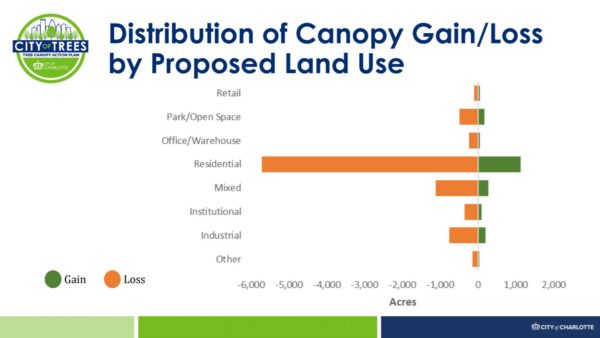
Wow! Most of Charlotte’s tree canopy is being lost within residential neighborhoods. Here’s what it looks like by neighborhood. Notice that much of the south Charlotte “wedge” has a higher rate of tree loss than the “crescent”. This is likely due to infill development and re-development as small homes are torn down and larger homes are built. There’s also an increase in horseshoe-shaped driveways that take up more of a front yard. Many trees in the wedge are older and therefore more vulnerable to damage from storms and disease. Another major cause of tree loss is new development when homes are built on the outskirts of the city.

The City is now evaluating whether the goal of achieving a 50% tree canopy by the year 2050 is realistic and compatible with other City goals for development, transportation, and equity. Ensuring a strong tree canopy throughout Charlotte will take a genuine commitment from leaders, education and possibly incentives to help homeowners maintain large trees, and most importantly — a clear plan. We also recognize that different densities of development are appropriate in different parts of Charlotte. We’d expect to see fewer trees along light rail corridors and major thoroughfares, but those areas still need a healthy tree canopy.
Here’s a project timeline for the Tree Canopy Action Plan. Our Bike + Walk Program Coordinator Eric Zaverl serves on the Stakeholder Group for this process and he has been representing us on it since June. We’ll let you know when we find out the dates of public meetings beginning in September!
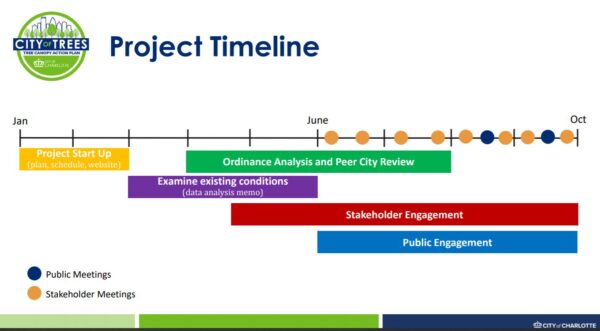
LYNX Silver Line light rail
Although you’ve probably already seen a general line on the map showing where the Silver Line will be built, the next step in the process is to refine the alignment. CATS CEO John Lewis and Senior Project Manager Andy Mock shared an update on the planning process.
As shown in the map below, CATS is analyzing 5 geographically distinct but connected focus areas for the Silver Line as the planning process becomes more fine-grained. They’re also considering what a future connection across the county line into Stallings might look like.
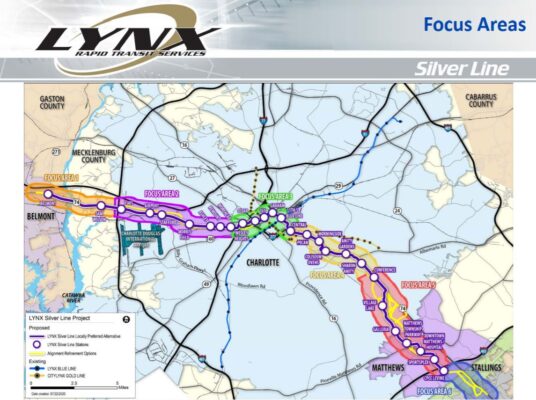
As CATS planners aim to determine exactly where the Silver Line tracks will be laid, they’re considering benefits and risks of different approaches. The goal is to maximize travel time & reliability, equitable development, and improved access & connectivity while minimizing the risk of conflicts & dependencies with other projects and third parties, upfront and ongoing costs, and environmental impacts. This is no easy task!
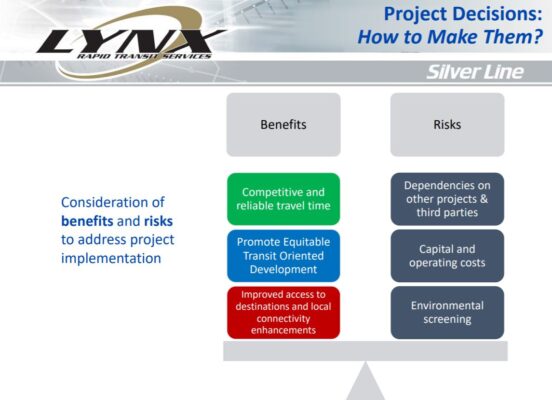
Council member Braxton Winston (At Large) asked how Transit-Oriented Development (TOD) zoning can be done ahead of time to ensure the kind of development that the city wants to see. Mr. Mock replied that the zoning team will be working to coordinate this with the planning effort for the alignment.
Council member Winston also said he hopes that intergovernmental efforts between the City of Charlotte, Mecklenburg County, and Charlotte Mecklenburg Schools will work towards integrating planning of future public schools and social services to maximize the community’s investment in the Silver Line. He pointed out that the Silver Line will pass through neighborhoods that were destroyed in the name of “urban renewal” in the early and mid 20th century, and hopes to see a restorative justice approach as the Silver Line is built and development happens around it. Council member Julie Eiselt (At Large) also voiced her support for this approach.
Public meetings will be held in September to hear feedback on the alignment refinement. Following some additional planning work, there will be another round of public meetings in the November/December timeframe. Then in February or March, the Metropolitan Transit Commission will vote to adopt the recommendation.
We’ll keep you updated about opportunities to participate in virtual public meetings. Your voice is needed to let CATS know if they’re on the right track with their recommended alignment refinement and risks & benefits analysis.
Charlotte Future 2040 Comprehensive Plan
Assistant City Manager and Planning Director Taiwo Jaiyeoba as well as Division Manager of Planning Alysia Osborne gave a brief update on the Comprehensive Plan. Here are key themes that have emerged through the public engagement process:
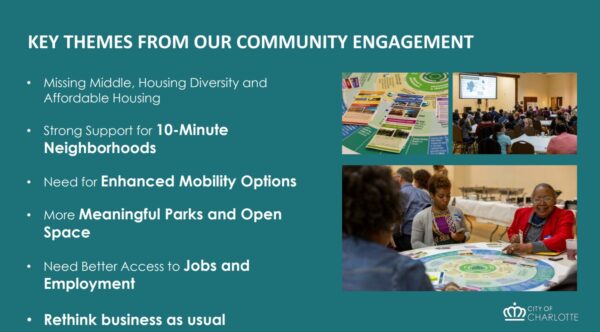
Equity is central to the process of creating a Comprehensive Plan that will help Charlotte grow in a way that corrects existing inequities and provides opportunities for all. As shown on the figure below, there are some similarities and differences between the “crescent” of north, south, and east Charlotte compared to the “wedge” of south Charlotte. The most striking differences are in the areas of vulnerability to displacement, job density, job skill match, residential renovations, and size of commercial properties.
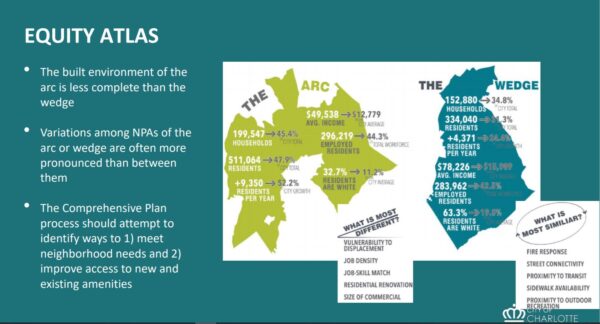
Want to add your voice to the Comprehensive Plan process?
- Participate in the City’s next Ambassadors’ & Strategic Advisors’ Virtual Engagement Activity and help plan for a healthier, more resilient, and more equitable Charlotte! This activity is available through August 26.
- If you have kids or are just feeling artistic, download and color this awesome art by Marcus Kiser and post it to the City’s Planning social media pages.
Charlotte Moves Task Force
Good news! We’ve summarized the panel discussion from the July 23rd meeting on our blog. Check it out.
View the slides that were presented at the meeting. Transportation, Planning, and Environment Committee meetings are typically held from 10:30am – 12:00pm on the 4th Monday of each month. Meetings are streamed live on the City of Charlotte’s Facebook and YouTube channel. Learn more.
Thanks for reading!
As a nonprofit, community support is essential for us to keep doing what we do — including providing free articles like this. If you found this article helpful, please consider supporting Sustain Charlotte.
Want to stay in the loop? Subscribe to our weekly newsletter and follow us on Instagram, Facebook, and Twitter.
